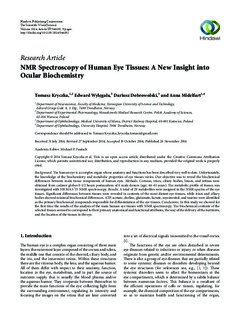| dc.contributor.author | Kryczka, Tomasz Aleksander | |
| dc.contributor.author | Wylegala, E | |
| dc.contributor.author | Dobrowolski, D | |
| dc.contributor.author | Midelfart, Anna | |
| dc.date.accessioned | 2019-10-31T07:45:40Z | |
| dc.date.available | 2019-10-31T07:45:40Z | |
| dc.date.created | 2015-01-13T14:57:16Z | |
| dc.date.issued | 2014 | |
| dc.identifier.citation | Scientific World Journal. 2014, 546192. | nb_NO |
| dc.identifier.issn | 1537-744X | |
| dc.identifier.uri | http://hdl.handle.net/11250/2625497 | |
| dc.description.abstract | Background. The human eye is a complex organ whose anatomy and functions has been described very well to date. Unfortunately, the knowledge of the biochemistry and metabolic properties of eye tissues varies. Our objective was to reveal the biochemical differences between main tissue components of human eyes. Methods. Corneas, irises, ciliary bodies, lenses, and retinas were obtained from cadaver globes 0-1/2 hours postmortem of 6 male donors (age: 44–61 years). The metabolic profile of tissues was investigated with HR MAS 1H NMR spectroscopy. Results. A total of 29 metabolites were assigned in the NMR spectra of the eye tissues. Significant differences between tissues were revealed in contents of the most distant eye-tissues, while irises and ciliary bodies showed minimal biochemical differences. ATP, acetate, choline, glutamate, lactate, myoinositol, and taurine were identified as the primary biochemical compounds responsible for differentiation of the eye tissues. Conclusions. In this study we showed for the first time the results of the analysis of the main human eye tissues with NMR spectroscopy. The biochemical contents of the selected tissues seemed to correspond to their primary anatomical and functional attributes, the way of the delivery of the nutrients, and the location of the tissues in the eye. | nb_NO |
| dc.language.iso | eng | nb_NO |
| dc.publisher | Hindawi | nb_NO |
| dc.rights | Navngivelse 4.0 Internasjonal | * |
| dc.rights.uri | http://creativecommons.org/licenses/by/4.0/deed.no | * |
| dc.title | NMR spectroscopy of human eye tissues: A new insight into ocular biochemistry | nb_NO |
| dc.type | Journal article | nb_NO |
| dc.type | Peer reviewed | nb_NO |
| dc.description.version | publishedVersion | nb_NO |
| dc.source.volume | 2014 | nb_NO |
| dc.source.journal | Scientific World Journal | nb_NO |
| dc.source.issue | 546192 | nb_NO |
| dc.identifier.doi | 10.1155/2014/546192 | |
| dc.identifier.cristin | 1196831 | |
| dc.description.localcode | Copyright © 2014 Tomasz Kryczka et al. This is an open access article distributed under the Creative Commons Attribution License, which permits unrestricted use, distribution, and reproduction in any medium, provided the original work is properly cited. | nb_NO |
| cristin.unitcode | 194,65,30,0 | |
| cristin.unitcode | 1920,11,0,0 | |
| cristin.unitname | Institutt for nevromedisin og bevegelsesvitenskap | |
| cristin.unitname | Klinikk for ØNH, kjeve- og øyesykdommer | |
| cristin.ispublished | true | |
| cristin.fulltext | original | |
| cristin.qualitycode | 1 | |

